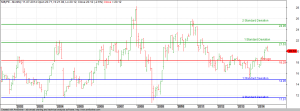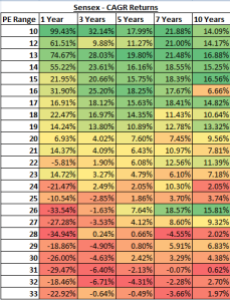As Iraq boils over and America once again gets ready to intervene (albeit for now with only Air Assaults), markets seem panicky. But if history is anything to go by, Wars represent a opportunity rather than a threat for the prepared investor.
While we have had thousands of wars over hundreds of years, I have picked the most well known among them for the sake of simplicity as well as the fact that the damage these did (human and otherwise) was the biggest we have ever seen.
I have for now excluded wars where India was a participant (against Pakistan / China) since with the economy being closed and we not really having a stock Index, data (RBI Index data) is not exactly a reliable source of information as to what really happened.
First off, the following chart represents the time line of World War I
While US markets dived in the very month major hostilities started, the fact that markets also closed for few months would have had a impact on the behavior as well and hence one would need to look at it from the perceptive of how markets traded once it restarted in Jan of 1915. Dow not only recovered all the losses in the coming months but actually made a multi-year high.
Here is the chart representing the period of World War II
A bit different from what happened in World War I with markets actually slowing moving down as hostilities in Europe opened up (do note that US did not officially enter the War until the bombing at Pearl Harbor). But by the time America entered, markets had already bounced of the bottom and once the war ended, we saw a multi decade bull market with the levels being seen during World War II never being seen again (more due to change of world order which was purely due to the War).
While the next major war was the Korean war which resulted in the division of Korea, the actual time of war was pretty short in comparison to previous wars discussed above and the markets (Dow Jones) seems to have not even bothered about it as it went about its business.
One of the highest military and civilian causalities the world saw after World War II was the Vietnam War. Markets though once again went on with the business as usual approach and major dips were a occasion to buy than panic and sell as the charts clearly shows us (of course, in hindsight with perfect knowledge, its all very easy now 🙂 )
The Invasion of Kuwait by Iraq resulted in the first Gulf War and in a way what we see today in Iraq is a indirect result of that decision by Saddam Hussein. In the last 25 years, while much of the world has improved by leaps and bounds, Iraq has gone so back that it will take years just for it to get back to where it stood in 1990 (even accounting for the devastation they saw during the Iran-Iraq war).
While Dow did fall in the intial stages of the war especially as Crude Oil spiked and rekindled fears of the Oil Spike the world saw in 1973, once those fears got removed, markets rebounded strongly and on the charts, appears as a mere blip in the long bull rally Dow saw between 1987 to 2000.
If there was any hope for Iraq to become a normal country again, the Second Gulf War more or less buried any hope. Markets though loved this war too and in a way can be seen as the first major rise in the 2003-2008 bull rally.
As panic once again strikes the market, I am reminded of this best selling book “This Time is Different” by Carmen M. Reinhart and Kenneth Rogoff. Market behaviour does not change and there is no doubt that the end result will we way different than the prophetic sayings one sees during this time.
I believe one needs to wait for the right opportunities to present themselves and when they do, make the max of it. For no matter what happens, the world will not end because of one war or one sanction (Russian Sanctions being more of a joke especially as they are dependent on Imported items that they have just banned more).
The saying “One man’s misfortune is another man’s gain” is something that is apt for the current time and circumstances.








